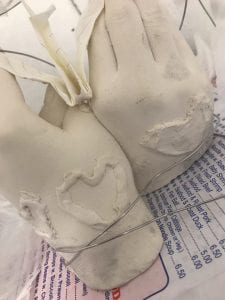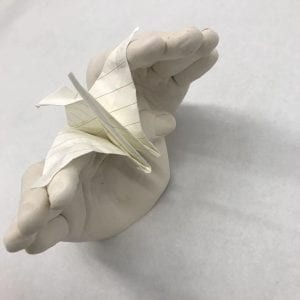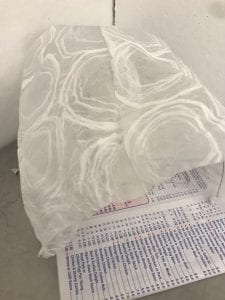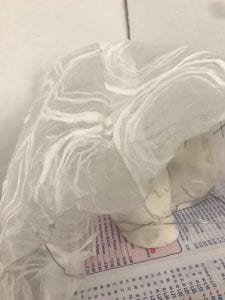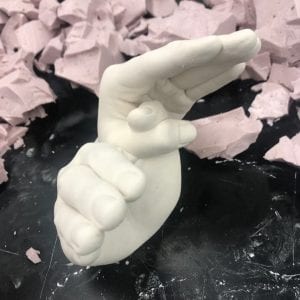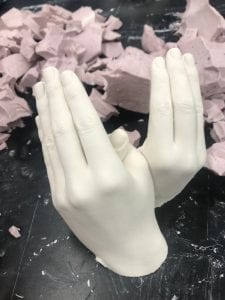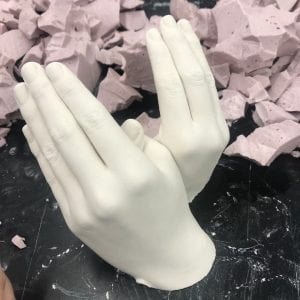1. Part 1: Describe your process of making an alginate body mold and a plaster cast, and explain when and how in that process you altered the cast.
As you can see my cast is made by two hands. Two hands are connecting each other by thumbs. So when you see the back it looks like a bird. In the beginning, I have a little problem to put my hands inside of the plastic bottle, but then I see the alginate it is very smooth so when I put my hands inside it has more space than I thought.
Describe the nature/feelings/character of the memory you cultivated through the orientation, gesture, and alteration of the cast.
The memory’s from my When I was a child, I learned the TOEFL period. When I was alone, I felt lonely at home. The model cast it is looks like a bird it’s want to show escape what’s free.
2. Part 2: What kind(s) of inhabitable space(s) in the real world inform the inhabitable space you made?
Carefully and specifically describe the qualities, character, psychological state, sensations, and atmosphere you would like your inhabitable space to evoke from your memory.
The real world inform the inhabitable space I made is my bedroom. I want to evoke alone tried being binding in my real world inform.
3. Part 1 and Part 2: Discuss the design elements of mass, texture, and volume and their relationship to each other in your project.
I added love to the surface of the model, wanting to express a kind of love and expectation from parents so that I can’t “fly” and create a heavy feeling.
4. How does the design principle of repetition play a role in the organization of space or material in your work?
5. A. Name the found object(s) used in the construction of your inhabitable space and explain what meanings or content the found object brings to your piece from its intended use/function/associations as an ordinary mass-produced object. B. Explain how you directed or added new meaning/content to the found object(s) in your piece through modification, making processes, and/or physically unifying it into your piece as a whole.
You can find a Chinese takeaway menu in my project, the menus we can see everywhere in our lives. In my project, I sewed the menu and cardboard together and wrapped the model underneath the model. This is a reason from my memory because, at that time, I can only go out and sell often, even if I am now, so it is a portrayal of my life.
6. Explain how you tailored your inhabitable space to your cast, or how you customized a space specifically for your cast to inhabit (discuss ergonomics, contact points between structure and cast, the relationship between surfaces, the size of the space, and the proportion of negative space to your altered cast).
The inhabitable space to my cast is covered it from the cage, but the two sides are open. From the above, it will create a feeling of a shroud that will make people feel depressed, but there is a kind of stubborn survival in the open air circulation on both sides.
7. Discuss how and where in the classroom you presented your finished project 2, and why you chose to display your piece that way.
I chose to put my project in the corner in the classroom, because of the inhabitable space I want to show that I want to escape wants to hide, hard to be found. And being binding.
8. Discuss other important aspects of your project not mentioned above, such as how you delineated interior/exterior space, how you designed a threshold, how energy flows into, through, and out of your piece, how senses besides sight are involved in experiencing your project, how you used light or color, or anything else you wish to discuss.
I designed an arched “roof” to put the model inside. Wrapping the model with a wire wants to express a bondage and also plays a fixed role. Expressing a sense of reality that wants to escape but is bound to escape. I didn’t create a completely closed space. It was a more desperate feeling, it was easy to escape but was tied.
9. Write about three specific ways your work for this project relates to the work of artists we studied for this project, which includes artists from the videos, the reading, and class lecture. Make sure you include each artist’s name (ask if you cannot remember).
I got my space ideal from the artist Do Ho Suh: His artwork to showing that missing home. It influences me so I made my space is my bedroom I want to create a lonely feeling. For my plaster cast from the video artist Louise Bourgeois, her work of two hands holding together evokes feelings of intimacy and human relationship. My two hands holding together evokes feelings of freedom and lonely want to escape. Artist Doris Salcedo she built everything accurately meters by meters. The building process starts with her decisive ideal and the teamwork along with her idea using digital technology to get the framework.
10. To you, what is the most important or exciting aspect of your project or your process for project 2?
The most important is to create a space using the found object. I have always got wrong what is found an object and when I using the found object to trying to make my memory is a really exciting to me to bring the same feeling people gonna feel from my space.
